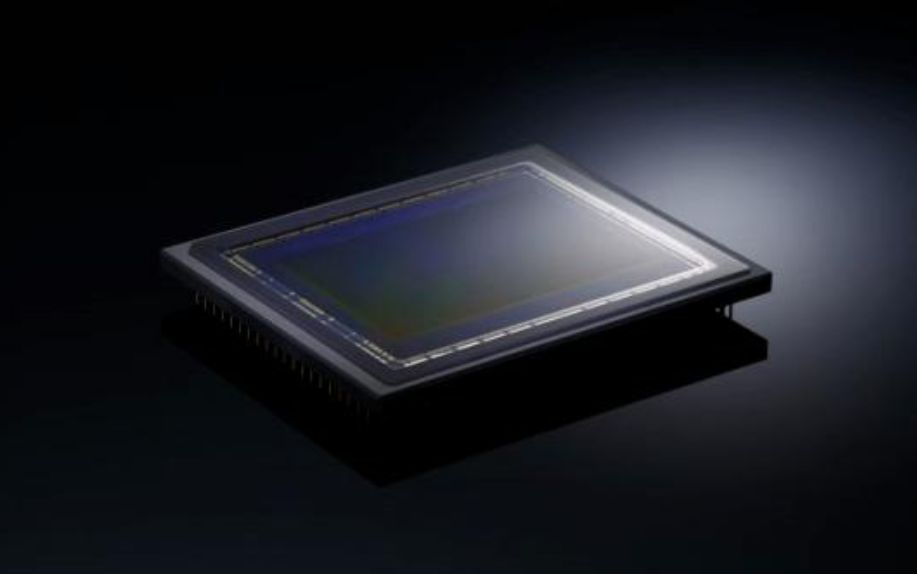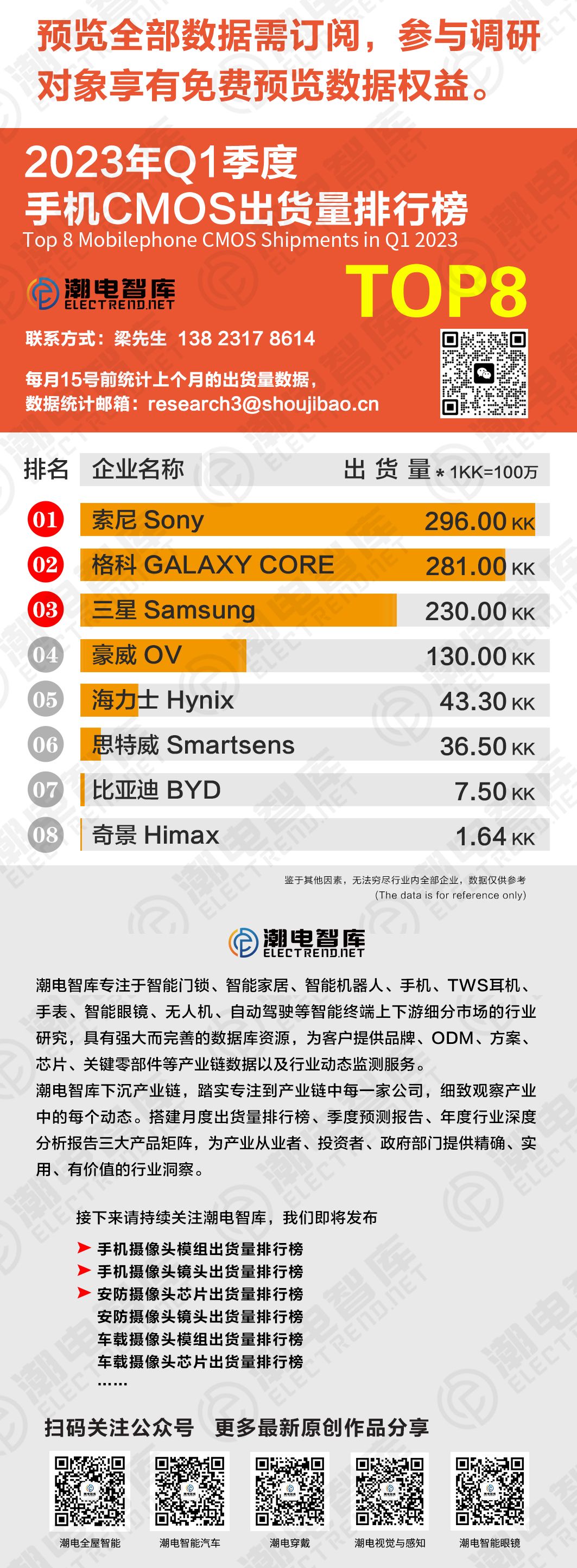手机一直是CMOS图像传感器最大的应用领域,目前占比近七成。
根据潮电智库统计,今年Q1全球智能手机市场销量为2.8亿部,环比下降7%,同比下降14.7%;中国智能手机市场环比增长10%,同比下降5%。
某一线品牌手机厂商高管直言,“没想到第一季度才是真正的至暗时刻。”

从Q1手机CMOS芯片全球出货量情况来看,索尼、格科微、三星分列前三名,呈现中日韩三足鼎立局面。原来在第一梯队的豪威表现欠佳,老牌厂商海力士也滑坡严重。

值得注意的是,Q1中国手机市场相比此前季度两位数的同比降幅明显收窄,这被视为行业回暖的迹象。更有多家供应链企业向潮电智库透露,终端品牌手机厂商的库存清理工作已近尾声,最迟五六月份基本可以全部完结,市场有望于下半年反弹。
华为、小米、OPPO、vivo、荣耀等中国品牌正在以影像创新升级,以及折叠屏形态全力冲击苹果与三星的高端手机地位。在“降本增效”战略指引下,潮电智库认为,与马达和镜头等其他手机摄像头器件发展路线相似,中高端CMOS会是新一轮的争夺点,以格科微为代表的国产厂商会凭借高性价比竞争优势赢得替代良机。
其中难度很大,空间也更大。
前三抢走八成份额
车载、安全及IoT等新兴领域正在推动CMOS持续增长,但手机类应用仍将保持其关键的市场地位。
根据潮电智库统计,今年Q1索尼、格科微、三星这前三厂商手机CMOS总出货量807KK,占比榜单总出货量78.66%,资源进一步向头部集中化趋势明显。
相关数据显示,Q1苹果公司在中国智能手机市场占据最大市场份额。其iPhone系列销量同比增长6%,市占率达19.9%,成为自2014年以来市场份额最高的第一季度,同时也成为自2015年以来销量最高的第一季度。
作为苹果手机的核心CMOS供应商,索尼从中充分受益,Q1以296KK出货量暂时领先,而且在高端市场体现出强大的统治力。
除了苹果iPhone系列持续大卖,安卓手机阵营整体销量Q1持续走低,这也直接影响了格科微和三星CMOS产品的销量。
根据潮电智库统计,OPPO、小米、vivo等在第一季度出现同比两位数下滑;即便强如全球手机销量老大三星,同期出货量也下滑了18.7%。
值得注意的是,Q1中国智能手机销量同比下降5%,相比前几个季度两位数的同比降幅大为收窄。
潮电智库从手机CMOS重要下游光学模组厂商处了解,因终端品牌新机发布驱动,4月手机摄像头出货量触底反弹迹象明显,市场释放出积极信号。
另据产业链反馈信息,安卓各大手机品牌将于最近一两个月内完成库存清理。因此可以判断,手机行业在下半年会呈现趋稳甚至上扬的发展态势,其中消费体验感最强的影像系统会持续创新升级。
以出货量口径计算,格科微2022年市占率高达26%,并连续十多年成为全球手机CMOS销冠。潮电智库分析认为,如果手机市场回暖,凭借高效的供应链协调能力,以及三星、小米、OPPO、vivo、联想等丰富的品牌客户群体,格科微仍是2023年度全球手机CMOS出货量冠军最有力的争夺者。
高端渐成主战场
根据潮电智库不完全统计,截至今年4月,各品牌手机已经发布近30款新机型(含折叠屏)。在影像配置方面,不管是高端旗舰还是冲量机型,5000万像素为主流后摄,如小米13 Pro、三星Galaxy S23、OPPOFind N2 Flip、vivo X90等。据外媒消息,苹果iPhone 15全系会采用4800万像素摄像头。
为了抢占高端市场份额,三星、华为、小米、OPPO、vivo、荣耀等安卓一线品牌全部推出了多款折叠屏手机,其中不少已经搭载3200万像素前摄,这一规格有望成为折叠屏准标配。
多年来,3200万像素以上高端手机CMOS市场基本由索尼、三星等海外厂商垄断,虽然豪威占有一定的份额,但由于其“混血基因”(本是美企,被中国企业韦尔股份收购),行业普遍观点认为不算严格意义上的国产力量。
当前终端品牌纷纷采用“降本增效”运营战略,国产手机CMOS厂商则积极破冰,在技术、产品、服务等多层面创新突进。不难预见的是,原来国内外厂商在中低端、高端手机CMOS“泾渭分明”的供应格局可能在今年会被打破,其中以3200万像素的市场争夺会尤为激烈。
今年4月,格科微在2022年度业绩公告中称,公司独有的高像素单芯片集成技术已经研发成功。GC32E1是格科微首颗基于最新FPPI专利技术0.7μm像素的CMOS产品,支持3200万全像素输出。目前该产品已通过工程测试并获得品牌客户认可。

格科微董秘兼财务总监郭修贇在业绩会上表示,未来希望用两年时间进入安卓市场的高端芯片阵营,从0市场占有率逐步到15%~20%。后续公司将推出基于0.7-1.0u的3200万、5000万、1亿等一系列更高像素规格的手机CMOS产品。
潮电智库从多家一线手机摄像头模组厂商佐证,由于索尼、三星等CMOS图像传感器的采购单价较高,中国手机品牌对于摄像头供应链资源更倾向于本土化,如镜头、马达、滤光片等国产器件已经站稳高端。
更有产业链专家认为,CMOS图像传感器是手机摄像头最重要的结构件,占了50%的成本,如果能够在高端应用成功实现国产替代,甚至会影响到整个手机行业的变局。
小结性价比才是王道
受消费经济低迷、产品创新不足、换机周期延长等多重因素影响,2022年全球手机市场整体低迷,被称为行业近十年寒冷的一年。
强烈的去库存需求,更导致手机CMOS产品价格竞争加剧。
未来三年甚至更长时间内,手机仍将是CMOS图像传感器最重要的市场。出货数量、产品结构、客户群体以及收入质量,会成为CMOS企业运营的关键性指标,其中最核心的比拼,在于如何以高性价比产品方案赋能下游及终端客户,助其“降成本,升体验”。
据潮电智库了解,为了强化产品竞争力,在GC32E1的研发过程中,格科微创新的采用了高像素单芯片集成技术,相比于市场上同规格双片堆叠式CMOS,消除了下层堆栈的逻辑芯片发热带来的像素热噪声,面积仅增大约8%,显著提高了晶圆面积利用率,大大改善成本结构。
2023年手机CMOS之战,将比以往更为精彩。
Analysis of Global Mobile CMOS Sales in Q1 2023: The Battle between Mid and High end, in which the price wins
Mobile phones have always been the largest application field of CMOS image sensors, currently accounting for nearly 70%.
According to statistics from Chaodian, the global smartphone market sales in Q1 this year were 280 million units, a decrease of 7% month on month and 14.7% year-on-year; The Chinese smartphone market grew by 10% month on month and decreased by 5% year-on-year.
A senior executive from a top tier mobile phone manufacturer bluntly stated, “I didn’t expect the first quarter to be the real darkest moment.
From the global shipment volume of Q1 mobile phone CMOS chips, Sony, Galaxycore and Samsung are ranked in the top 3, presenting a tripartite situation between China, Japan, and South Korea. Originally, Howell’s performance in the first tier team was poor, and the veteran manufacturer Hercules also experienced a serious decline.
It is worth noting that in Q1, the year-on-year double-digit decline in the Chinese mobile phone market has significantly narrowed compared to the previous quarter, which is seen as a sign of industry recovery. More than one supply chain enterprise has revealed to the Chaodian Think Tank that the inventory clearance work of terminal brand mobile phone manufacturers is nearing completion, and the market is expected to rebound in the second half of the year by May or June at the latest.
Chinese brands such as Huawei, Xiaomi, OPPO, vivo, and Honor are striving to compete with Apple and Samsung’s high-end smartphone positions through innovative imaging upgrades and foldable screen formats. Under the guidance of the “cost reduction and efficiency improvement” strategy, Chaodian believes that, similar to the development path of other mobile camera devices such as motors and lenses, mid to high-end CMOS will be a new round of competition points, and domestic manufacturers represented by Gekewei will win replacement opportunities with high cost-effectiveness competitive advantages.
The difficulty is great and the space is also greater.
The top three share 80%
Emerging fields such as automotive, safety, and IoT are driving the continuous growth of CMOS, but mobile applications will still maintain their critical market position.
According to statistics from Chaodian, in Q1 this year, Sony, Galaxycore, and Samsung, the top three manufacturers, had a total shipment volume of 807KK of mobile CMOS, accounting for 78.66% of the total shipment volume on the list. The trend of resource concentration towards the top is evident.
As the core CMOS supplier of Apple smartphones, Sony has fully benefited from it, with Q1 temporarily leading with a shipment volume of 296KK and demonstrating strong dominance in the high-end market.
In addition to the continued high sales of Apple’s iPhone series, the overall sales of the Android phone camp have continued to decline in Q1, which directly affects the sales of Gekewei and Samsung CMOS products.
According to statistics from Chaodian, OPPO, Xiaomi, vivo, and others experienced a double-digit year-on-year decline in the first quarter; Even if it is as strong as Samsung, the global leader in mobile phone sales, its shipment volume has decreased by 18.7% during the same period.
It is worth noting that in Q1, the sales of smartphones in China decreased by 5% year-on-year, significantly narrowing the double-digit year-on-year decline compared to the previous quarters.
Chaodian learned from important downstream optical module manufacturers of mobile CMOS that due to the release of new terminal brands, there were obvious signs of a rebound in mobile camera shipments in April, and the market released positive signals.
According to feedback from the industry chain, major Android phone brands will complete inventory clearance within the next month or two. Therefore, it can be inferred that the mobile phone industry will show a stable or even upward development trend in the second half of the year, with the imaging system with the strongest consumer experience continuing to innovate and upgrade.
Based on the shipment volume, Galaxycore Micro’s market share reached 26% in 2022 and has become the world’s top seller of mobile CMOS devices for more than ten consecutive years. According to the analysis of Chaodian, if the mobile phone market recovers, with efficient supply chain coordination capabilities and a rich customer base of brands such as Samsung, Xiaomi, OPPO, vivo, and Lenovo, Galaxycore will still be the most powerful contender for the global mobile phone CMOS shipment champion in 2023.
High end market competition
According to incomplete statistics from Chaodian, as of April this year, nearly 30 new models (including foldable screens) have been released by various brands of mobile phones. In terms of image configuration, whether it is a high-end flagship or impulse model, 50 million pixels are the mainstream rear camera, such as the Xiaomi 13 Pro, Samsung Galaxy S23, OPPOFind N2 Flip, vivo X90, etc. According to foreign media reports, the entire Apple iPhone 15 series will use a 48 megapixel camera.
In order to seize high-end market share, top Android brands such as Samsung, Huawei, Xiaomi, OPPO, vivo, and Honor have all launched multiple foldable screen phones, many of which are already equipped with a 32 megapixel front camera. This specification is expected to become a standard foldable screen configuration.
For many years, the CMOS market for high-end mobile phones with a pixel size of over 32 million has been largely monopolized by overseas manufacturers such as Sony and Samsung. Although Howell holds a certain share, due to its “hybrid genes” (originally a US company acquired by Chinese company Weir), the industry generally believes that it is not strictly a domestic power.
Currently, terminal brands are adopting a “cost reduction and efficiency increase” operation strategy, while domestic mobile phone CMOS manufacturers are actively breaking the ice and innovating at multiple levels such as technology, products, and services. It is not difficult to foresee that the original supply pattern of domestic and foreign manufacturers in mid to low end and high-end mobile CMOS devices may be broken this year, with a particularly fierce market competition of 32 million pixels.
In April of this year, Galaxycore announced in its 2022 performance announcement that its unique high pixel single chip integration technology had been successfully developed. GC32E1 is Galaxycore Micro’s first patented technology based on the latest FPPI 0.7 μ The M-pixel CMOS product supports 32 million full pixel outputs. At present, the product has passed engineering testing and received recognition from brand customers.
Guo Xiuyun, director secretary and chief financial officer of Galaxycore, said at the performance meeting that he hopes to enter the high-end chip camp of the Android market in the next two years, from 0 market share to 15% to 20%. The following company will launch a series of higher pixel mobile CMOS products based on 0.7-1.0u, 50 million, 100 million and so on.
Chaodian from a number of first-line mobile phone camera module manufacturers evidence, due to SONY, Samsung and other CMOS image sensor purchase price is high, Chinese mobile phone brands are more inclined to localization of camera supply chain resources, such as lens, motor, filter and other domestic devices have been a firm high-end.
Some industry chain experts believe that CMOS image sensor is the most important structural part of mobile phone camera, accounting for 50% of the cost. If domestic replacement can be successfully achieved in high-end applications, it will even affect the changes of the whole mobile phone industry.
Summary: the price is king
Affected by multiple factors such as the sluggish consumer economy, insufficient product innovation and the prolonged replacement cycle, the overall downturn of the global mobile phone market in 2022 is known as the cold year of the industry in the past decade.
The strong demand for destocking also leads to the intensified price competition of mobile CMOS products.
Over the next three years or more, mobile phones will remain the most important market for CMOS image sensors. Shipment quantity, product structure, customer group and income quality will become the key indicators of CMOS enterprise operation. Among them, the core competition lies in how to empower downstream and end customers with cost-effective product solutions to help them “reduce costs and improve experience”.
According to Chaodian, in order to strengthen product competitiveness, in the process of GC32E1 development, division micro innovation adopted high pixel single chip integration technology, compared to the market with the specification double stacked CMOS, eliminate the lower stack logic chip heat pixel thermal noise, area only about 8%, significantly improve the wafer area utilization, greatly improve the cost structure.
The battle for mobile CMOS in 2023 will be even more exciting than ever.